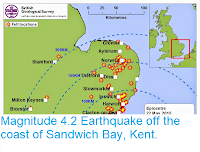Around 20 households have been evacuated following a landslide on the north coast of the Isle of Sheppey, on the north coast of Kent in southeast England, on Monday 1 June 2020. The event, a slump on an exposure of London Clay in the cliffs, is about fifteen metres wide and about two metres deep, and partially undermined one house, with the clear potential to extend further, leading the Kent Fire and Rescue Service to order the evacuation of twenty homes, with a further thirteen warned that they could be asked to leave if the slip spread further.
Aerial view of a landslide that partially undermined a house on the north coast of the Isle of Sheppey on Monday 1 June 2020. Kent Fire and Rescue Service.
Photographs of the landslide show excessive water pooled within the slumped material, this is fairly typical of landslides, as excess pore
water pressure can overcome cohesion in soil and sediments, allowing them to
flow like liquids. Approximately 90% of all landslides are caused by heavy
rainfall. However, the north Kent coastal area has been suffering a prolonged bout of dry weather, making such an explanation for the event unlikely. Reports in the local press state that cracks were first seen on the cliffs on Friday 29 May, probably a result of dry cracking of the clay, and that locals had responded by pouring water onto the affected area in the hope of improving the cliffs cohesion, something which had reportedly worked in the past, but which seems highly likely to have triggered the landslip.
Wider angle view of the 1 June 2020 Sheppey landslip. SWNS.
The north coast of the Isle of Sheppey is popular with fossil collectors due to the large
number of Eocene fossils it produces. The London Clay outcrops directly on the
coast here, and as this is a poorly consolidated, soft sediment, it is easily
eroded by the action of the sea, revealing large numbers of highly
fossiliferous phosphate nodules, noted for the high quality plant macrofossils
(particularly Mangrove Plants) and marine invertebrates (particularly articulated Decapod Crustaceans) that
they produce. Unfortunately the same sediment makes conditions at the site
extremely treacherous, as the clay readily absorbs large volumes of water,
turning into a highly sticky mud that can cause cliff failures in the area, exposing new fossil material, but which can also trap the unwary, as the weight of a
human footfall is sufficient to squeeze the water out of the mud beneath the foot,
creating a vacuum that prevents the foot from being lifted again.
A fossil Shark's tooth from the London Clay on the north coast of the Isle of Sheppey. UK Fossils.
See also...
Follow Sciency Thoughts on Facebook.









